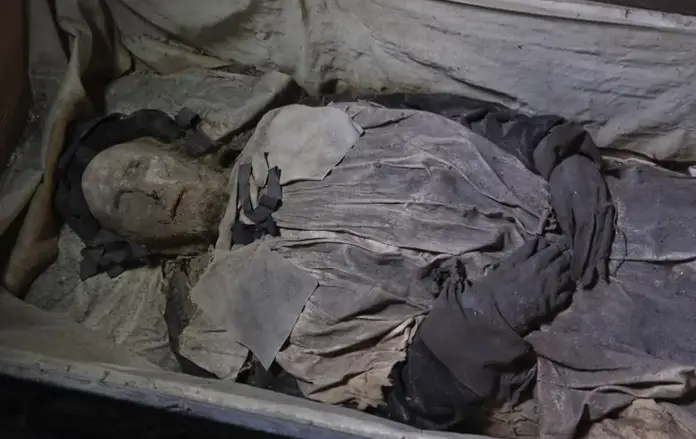 From a press release from Lunds Universitet...
From a press release from Lunds Universitet...
The mummified remains of Peder Winstrup are one of the best-preserved human bodies from the 1600s. Preliminary investigations reveal a sensational find: the internal organs are still in place.
WATCH: Unique mummy undergoes medical investigations:
“We can now observe that Winstrup’s mummy is one of the best-preserved bodies from Europe in the 1600s, with an information potential well in line with that offered by Ötzi the ice man or Egyptian mummies. His remains constitute a unique archive of medical history on the living conditions and health of people living in the 1600s”, says Per Karsten, director of the Historical Museum at Lund University.
Peder Winstrup, a bishop and prominent historical figure in Scandinavia, was one of the founding fathers of Lund University. He died in 1679 and was buried in the famous cathedral in Lund a year later. The coffin, together with its contents, constitutes a unique time capsule from the year 1679 with a well-preserved body, textiles and plant material.
Usually the internal organs would have been removed; in this case, however, the body was not embalmed in a traditional manner but simply dried out naturally. The good condition of the body seems to be the result of several factors in combination: constant air flow, the plant material in the coffin, a long period of illness resulting in the body becoming lean, death and burial during the winter months of December‒January and the general climate and temperature conditions in the cathedral.
In December Peder Winstrup underwent a CT scan at the University hospital in Lund. The preliminary results show that the body is relatively well preserved and it was possible to identify most of the internal organs.
The first results show dried fluid and mucus in the sinuses, indicating that Winstrup had been bedridden for a long period before he died. Calcifications in the lung could indicate both tuberculosis and pneumonia. Plaque was also found in the left coronary artery of the heart, the aorta and the carotid artery, indicating that the bishop suffered from atherosclerosis.
“The gall bladder also has several gallstones, which could indicate a high consumption of fatty food”, says Caroline Ahlström Arcini, an osteologist working on the project.
Peder Winstrup, who lived to the age of 74, also suffered from osteoarthritis in both the knee and hip joints. In addition, he had lost a number of teeth. Traces of caries were found in a couple of the remaining teeth, which would indicate that he had access to sugary foods.
“His right shoulder was slightly higher than his left, due to an injury to a tendon in the shoulder. This would have limited Winstrup’s mobility, making it difficult for him to carry out simple everyday tasks such as putting on a shirt or combing his hair with the comb in his right hand”, says Caroline Ahlström Arcini.
An unexpected discovery that emerged from the CT scan was a four- or five-month old foetus, well hidden in the coffin under Winstrup’s feet. Nobody knows who put the foetus there.
“You can only speculate as to whether it was one of Winstrup’s next of kin, or whether someone else took the opportunity while preparing the coffin. But we hope to be able to clarify any kinship through a DNA test”, says Per Karsten.
The next step will be investigations into the textiles in the coffin, as well as further study of the body. Tissue samples from the internal organs are to be removed, among other things. In addition, the extensive plant material in the coffin will be investigated.


So interesting, will look out for more information on the fetus.
The fetus could have been placed there by a grieving mother or father? What better way to be sure your baby goes to heaven than to be buried with the bishop.
In the British series, Call the Midwife, still born babies were placed in the coffins of strangers. They weren’t considered people yet, but they deserved burial.
I don’t understand you statement that the child was not considered a person yet. No one back then would of thought that the child was not a person but should still be buried. You are imposing a feminist interpretation of a foetus as sub-human which no one in the 17th Century would have believed.
So cool… not so much for him because he was likely very uncomfortable for a long time… but for us, huzzah!
Do the scientists have any idea how mummification was achieved? Could the plant material found in the coffin have preserved his body? This could be quite a step forward from the Egyptian methods of preservation.
“The good condition of the body seems to be the result of several factors in combination: constant air flow, the plant material in the coffin, a long period of illness resulting in the body becoming lean, death and burial during the winter months of December‒January and the general climate and temperature conditions in the cathedral.”
Wow!!
I think this is amazing,We can learn so much about our past thru the dead.
We find it a terribly abomination to desecrate a buried person. Talking about removing His Exvellency’s internal organs for science sake is horrific. He was buried and to remain there till the end of time. Such disrespect and lack of compassion for this man.
He has been dead for a very long time. We learn from these kinds of things. It is amazing that he is so well preserved. I only wish that if I lived at a time like this, people in the future could find my body and help paint a picture of how life was when I was alive.
We find it a terribly abomination to desecrate a buried person. Talking about removing His Excellency’s internal organs for science sake is horrific. He was buried and to remain there till the end of time. Such disrespect and lack of compassion for this man.
I would imagine a man of learning and God would welcome the opportunity to teach future generations about the life he lived. There is so much he can still show us. He is not in his body, and the scientists will show him nothing but respect.
I’m glad to know that we preserve and honor our dead so that people can go back later and dig them up for testing. This right here is why I want to be thrown to the buzzards.
How did they come to find the body? Did they actually just dig it up to have a look. This shows so much disrespect. What would be the purpose of desicrating a grave.
An incredible find. Ew – sinus trouble. That’s one of the most miserable .. beside all of the other medical issues this gentleman had. A pretty rough go of it.
Where do you folks see that it said they actually “took out his organs”?? If you would either READ or just WATCH the video you would see they did nothing of the sort. They only used MRI’s and CAT Scans. Other than that he was barely touched.
I find this highly interesting especially the fact he is still recognizable.
I’ve been intrigued since I saw this story come across my facebook page recently. Apparently there are still no updates as to whether the baby is related to Bishop Winstrup. I would be quite interested in an update about the results of the DNA testing.